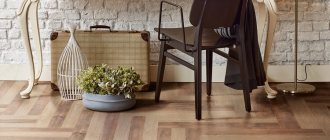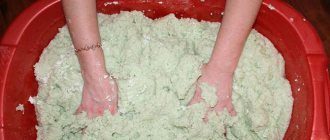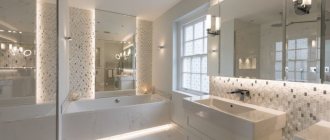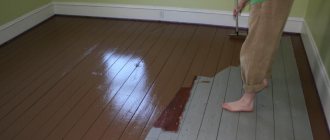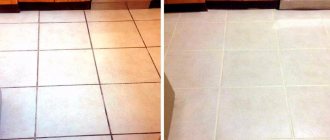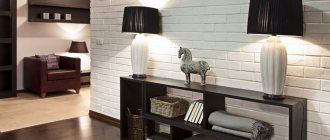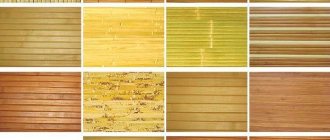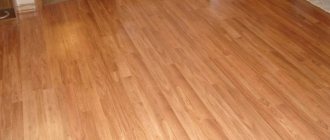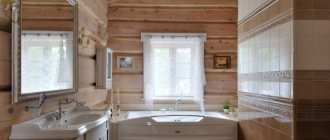Beauty, as we know, lies in simplicity. Simple things are also good because they don’t get boring, don’t lose their relevance and are easy to combine. All of the above is true for white tiles. A simple white finish is classic, solid and very versatile. White tiles will never go out of style. If the interior gets boring, you can always revive and diversify it with colored or neutral decor. The white background color will not conflict with it.
In connection with white tiles, the question of grout color often arises. Should it be pure white or can it be colored? Is it permissible to use dark compounds?
Let's start with the fact that the seams are usually made either in the color of the tiles, or in maximum contrast. This applies to any tile, not just white.
Tone-on-tone seams
Contrast seams
Highly contrasting means not being slightly different, but clearly standing out. It is not customary to grout the seams of white tiles with pale gray, cream, or beige compounds. Why? It's simple: if the contrast is minimal, the seams will appear dirty, making the surface look rather untidy.
So, the most common are three grout options for white tiles: - tone on tone with tiles; - gray; - black.
The use of bright colored grout is also possible. But this is a rather bold decision, and not for everyone. The colored seams are too conspicuous. They make any styling errors and manifestations of asymmetry noticeable.
Of course, the choice of colored grout must be dictated by something. Tile seams on the wall can repeat the color of porcelain stoneware floor tiles, paint, furniture elements, etc.
It is worth admitting that sometimes it looks quite interesting due to some playfulness and frivolity.
However, we started the article by talking about how simple (that is, natural, modest and unpretentious) things do not get boring for a long time. White tiles with colored joints are not one of these. When making repairs for many years, try to give preference to more traditional and universal solutions.
What's good about white tiles?
There are a lot of advantages. The strongest ones were chosen.
- Pairs with anything. Loyal to any color of grout and to a wide variety of companions: paint, plaster, microcement, wallpaper, wood and other materials.
- Suitable for bathrooms in any style - from minimalism to art deco and classics.
- Without getting dirty (no matter how strange it may sound). Soap stains, lime water, particles of dust and washing powder and other dirt in the bathroom in general are always grayish white in color. On light surfaces all this will be much less noticeable than on dark ones.
- Adds light and air. And in the bathroom, where there are not so often windows and daylight, white is a saving breath of air for those who feel comfortable only in bright interiors.
Fugues depending on the type of tile
To choose the right grout, you need to take into account some features of the tile:
- texture of the outside,
- features of the edges,
- main purpose: for floors or walls.
When laying tiles, give preference to mixtures of dry, finely ground cement. For porous or embossed tile products, you should not use liquid compounds sold in finished form, as they will clog all the cracks and bends.
Professionals do not recommend filling the seams of porous or embossed products with a thick seal; to do this, it is better to fill the joints with a semi-dry mixture and spray with water using a spray bottle so as not to carry dirt.
Abrasive sand particles can damage the tile surface with enamel or gilding, with imitation marble; to avoid this, grout the seams only with Portland cement. For glass tiles, epoxy-based mixtures are used.
If the tiles have even and smooth edges, then the seams will be narrow and neat. Otherwise they will be wider. Cement grout is used for joints up to 4 mm, cement-sand grout for more than 4 mm. Before use, be sure to read the instructions, there are always necessary recommendations there.
You can grout both floor and wall joints on tiles with the same compound, but only for the floor you should use compounds that are more durable. In addition, grout should be chosen in colors that do not stain, as the floor often gets dirty.
How to choose high-quality white tiles?
Traditionally, Spanish and Italian brands have the most reliable reputation. But to determine the quality, one made in Italy badge is not enough. And then, it turns out that tiles from other countries are worse by default? Of course not! To determine whether the tile is really of high quality, check with a consultant in the salon to find out what standards and tolerances it meets. Here are the most authoritative and reliable:
- DIN (Germany)
- UPEG (France)
- BS (UK)
- ASTM-ANSI (USA)
- UNI EN (Italy)
These tolerances ensure that the product is rigorously tested for wear resistance, has good geometry, low porosity and low water absorption, high strength and other important quality indicators. There is no doubt about such tiles, and the color will be uniform, bright, without yellowness or a grayish tint.
Main functions of grout
Once you have already decided on the tile, you need to choose the right grout color. It is designed to perform the following functions:
- protect building materials from moisture penetration;
- eliminate temperature gaps;
- decorate the surface.
The main task of the grout is to protect against moisture getting under the tiles.
Due to the fact that high humidity prevails in the bathroom, it is worth focusing on protecting the tiles from premature destruction. The putty is applied to the tile joints to ensure the tightness of the building material.
If there is high moisture in the room, it is worth caulking the seams to prevent premature destruction of the material.
Which grout should I choose for the bathroom, kitchen and hallway?
By purpose
Namely, where will it be used: in the kitchen, bathroom, will it be placed on the floor or on the walls? For example, if this is a kitchen apron (wall), then it is considered relatively dry - yes, water gets there, and it is periodically wiped with a damp cloth, but still there is much less contact with water compared to the bathroom. In these cases, an ordinary cement mixture is sufficient.
In damp rooms, you need something more durable - for example, polyurethane compounds. And when the surface is constantly in contact with water - in the same swimming pools or on the wall around the bathtub or shower - it is better to use an epoxy mixture.
According to operating features
So, if you are covering a deformable base, you need an elastic finish - this is polyurethane or “epoxy”.
The use of heated floors also imposes restrictions - hard cement will spread due to temperature changes and heat. Therefore, it is worth choosing more durable mixtures. In addition, pay attention to resistance to household chemicals - one way or another, you will use chemicals to clean the bathroom, or to clean grease from the kitchen apron.
Cement mixtures can only withstand alkaline compounds, and acidic cleaners destroy them. In this regard, it is a more universal “epoxy” that is compatible with any chemistry.
Seam width
The manufacturer indicates on the packaging information about the dimensions of the gaps for which they are suitable.
- For example, for gaps of no more than 3 mm, flexible products with mineral fillers are better suited.
- For 6 mm - putties with fine abrasives.
- And wide cracks of 10-20 mm should be sealed only with elastic mixtures or cement-based mixtures with large fractions.
Color combination options
Thanks to well-chosen color combinations, you can get three options for effects:
- One color. It is the simplest tandem, which is a single whole. A one-color combination is perfect for those who like a laconic, not too catchy design, and also allows you to mask some finishing imperfections in the form of uneven joints or chips.
- Contrasting grout. Gives the environment a special expressiveness and favorably emphasizes the geometry and laying of tile elements, giving them a deeper and richer look.
- Shades. Using this solution, you can unobtrusively highlight the geometric shape, pattern and color of the cladding, thereby creating a calm, expressive design.
The photo shows a bathroom interior with contrasting grout for wall and floor tiles.
Currently, there are collections of tiled models that already have a tinted putty solution. Most often, such a color palette is particularly original, for example, a black finish is complemented by a pearl-white fugue, a beige finish is complemented by grout in chocolate tones, and an olive finish is complemented by graphite.
Geometry
Let's talk separately about the figures. If the tiles are small, then by properly grouting the joints you can create different shapes along the contour. Including geometric designs. For example, you can make a large flower. To do this, take a bright color of grout, select one tile and finish it with mastic along the contour. Then other contrasting and bright colors are taken, and the petals are “drawn”. The result will be quite nice.
By the way, if this is your first time encountering such a decision, there is some interesting advice. To begin with, it is better to make your drawing on paper, using a checkered piece of notebook paper. It is very convenient when the white tiles are small in size and square in shape. Then, by drawing the cell with the intended pattern, it will be easier to transfer it to the tile.
As for the work itself, for the best effect, if the mastic is not homemade, you should use a thin, hard brush. And you definitely need a cloth to remove the remaining grout from the tile itself. Then, after drying, but not after a long time, the remaining mastic can be removed with soapy water or a soda solution.
Grout color palette
Different manufacturers have different color palettes. In basic colors like white, several grays and black, they overlap, but in others they differ significantly.
Grout Ceresit colors
The most commonly used grout in the CIS countries is ceresit. They have several types of grout CE 33, CE 40 and CE 25. The most commonly used grout is Ceresit CE 40 and it has the widest range of colors. Ceresite CE 40 holds moisture and minor deformations well, which means it is less likely to crack due to minor shrinkage and vibrations. Quite a good choice, but there are some nuances in the colors.
Everything is clear with neutral colors; you can get an idea about them by looking at the sticker on the jar or bag. But with more complex flowers, for example Jasmine, Crocus, Sahara and some others, strange things happen. The actual color after grouting and drying is not at all similar to what is indicated on the can.
Perhaps they are fundamentally different, perhaps the printing house conveys it poorly, but the fact remains: the choice of Ceresit grout color must be made after a trial application and drying. Yes, this complicates the process somewhat, but it is better to first buy a minimum amount, apply and let it dry, and then buy everything else. How to immediately wipe all the seams, and in fact remain dissatisfied with the resulting color.
Litokol grout colors
The Litokol brand has perhaps the widest range of grout types and color palette. We will mention their epoxy options later, because... they are not very popular due to their high price. But their line of regular grouts deserves attention.
Their Litochrom line includes, among other things, grout in our favorite gray colors in the amount of 4 pieces. We used all 4 in one apartment for different surfaces. There were no problems with them. What is important is that the color of the sticker on the packaging very closely reflects the final color of the seams after drying. Although Ceresit had no problems with the grays either.
Litokol C.10 gray and C.30 pearl gray can be used as basic universal grout colors.
Grout Satin colors
Another popular grout brand. It is used widely and the reviews are generally good. We have no experience working with it, so we’ll just give you a palette of Atlas grout colors.
Kiilto grout colors
Unfortunately, I also have no experience of using it, but I don’t want to invent it. But the Kiilto color palette is quite wide, we’ll just give it here. If you have experience using this or any other grout, please share it in the comments.
Two-component grout
It's very expensive. This type of epoxy grout is not particularly popular due to its price. In addition to the price, it is difficult to apply, difficult to remove excess residue and wash. If you have a decent budget and your builders have experience working with epoxy grouts, then they should be your choice. They are much more resistant to dirt and are not afraid of moisture at all.
And most importantly, epoxy grouts have a huge number of colors. Including all sorts of glosses, sparkles and even options that glow in the dark. The Litokol brand has a wide range of epoxy grouts. But all this is beyond the scope of this article.
Conclusions on what color of grout to use:
- The color of the tiles is darker for the floor and lighter for the walls.
- If you can’t find it in color, then use gray that matches in tone.
- White only for white tiles, only on the walls and not in the kitchen.
What are the types of grout mixtures: types, differences, pros and cons
The most common are dry mixtures. Manufacturers use cement with various additives as their base; they make the grout plastic, easy to use, water-repellent, etc. The powder can be used only after dilution (water, less often liquid latex), the proportions are always indicated on the packaging.
There are also synthetic types. They are immediately ready for use; usually you don’t need to add anything, but there are also those that require mixing with a hardener or dye.
Synthetic grout should be prepared right before work, and the process itself should not be interrupted.
In any case, the action is approximately the same: the mass is introduced into the spaces between the tiles, hardens, fastening the edges together. The result is a thick protective layer that does not allow moisture and air to destroy the integrity of the cladding.
Cement grouts
This type includes all grouting masses, the basis of which is a cement-sand or cement-polymer mixture. The composition allows you to use this option for gaps of different depths and widths. The affordable price makes this type the most popular and widespread.
pros
- Relatively low price.
- High strength, resistance to washout.
- It takes a long time to harden, but if the work was done with flaws, you can correct them without consequences.
- Easy to fix if the seam breaks over time.
Minuses
- Poor color palette due to the properties of the base material.
- It takes a very long time to dry and shrinks slightly after drying completely.
- The porous structure makes it impossible to use cement grout without antiseptic substances in a damp room (bathroom, bathhouse, etc.).
Epoxy and furan resin grouts
This option is a two-component one. Synthetic resin is combined with fine-grained colored sand, which not only further strengthens the seam, but also gives the desired color. After mixing the parts, the material becomes similar to chewing gum, and in its properties - like good plastic.
Epoxy grouts are ideal for working on areas of high humidity and are equally good for kitchens and pools.
As for furan mixtures, they can only be used in production, it is rarely found on sale and exists only in black.
pros
- 100% waterproof. Zero porosity, which means neither dirt nor moisture is a problem.
- Suitable for rooms that require frequent disinfection with strong detergents. Not afraid of powders or rough cleaning.
- For such grouts, neither open fire nor icy wind is dangerous. No temperature changes will affect the color. Manufacturers guarantee the safety of the coating for at least 30-50 years.
- It can take on any color and highlight the most unexpected interior design. Sequins, rhinestones, luminescent glow?
Minuses
- Significantly more expensive than other options. Often it is the high cost that cancels out all the many advantages.
- The mixture is easy to prepare, but working with it requires skill. You cannot hesitate and make mistakes, since the rate of hardening is very high.
- Slight surface roughness (due to fine sand in the composition) can create inconvenience, for example, when cleaning.
- Furan grout is not safe and cannot be used in apartments and houses where people and animals live. Only production premises with good ventilation.
Silicone grout
Another type of grout that is ideal for fine work. The silicone base does not allow moisture or air to pass through, adheres well and is not destroyed when exposed to most modern detergents (except chlorine).
pros
- The grout is relatively easy to work with and hardens quite slowly, allowing you to correct any unevenness.
- If necessary, it can be easily removed without leaving any traces.
- Suitable for wet areas, strong and durable.
Minuses
- When disinfected with chlorine products, it is gradually destroyed.
Latex grout
One of the expensive mixtures, which is usually not used in its pure form. Latex grout is purchased either to dilute the cement base, or is applied to the finished, dried seam after shrinkage.
The latex finish significantly increases the wear resistance of cement grout and makes it waterproof.
pros
- Good elasticity makes the latex grout mixture durable and not prone to cracking.
- Suitable for wide gaps (up to 3 cm).
- Lots of shades. Hundreds of color options available.
Minuses
- Expensive.
- It is necessary to immediately clean up the flaws, otherwise the tile will become cloudy forever in the place where the mixture has dried.
Which grout is suitable for light-colored tiles?
For classic white tile cladding, you can choose contrasting black or brown grout. The combination with red, burgundy fugue, as well as combinations with pastel peach, mint, pink, blue or blue grout are no less bold and impressive. Beige tiles go well with neutral chocolate, gray, milky tones or a darker fugue of black.
The photo shows a white tiled wall with a blue fugue.
Light blue tile finishes can be emphasized with white, yellow or dark blue colors.
The photo shows a bathroom with walls covered in blue tiles with white grout.
White tiles with dark grout
It will favorably emphasize the positive aspects of the bathroom design and hide possible defects in the renovation work. White tiles with dark grout do not need frequent repairs, as they are less susceptible to contamination. With the same success, the seams can be covered with a gray mixture. But with black grout the walls will look more original.
This option is very profitable. Using this approach you can hide defects
To make the appearance of the room unique, it is worth considering color options. But if any defects remain after construction work, then be prepared for the fact that they may appear.
White tiles with colored grout will make the design more original. For everything to look organic, it must repeat the tones of furniture or plumbing fixtures. By manipulating the color of the grout paste, you can create an attractive checkerboard effect.
Colored grout will add a little variety to the interior
Some useful tips on choosing grout
- A good tip for potential fugue buyers is to go to the store with a sample of the tile. And then at home, grout not the entire surface area, but only a small area that is located in an inconspicuous place. The fact is that grout can be sold both in dry form and in the form of a ready-made solution. And after drying, it may change its shade slightly.
- Note that when choosing in a store, you should think about other parameters besides color - manufacturer, type, cost, etc. Consultation with a sales consultant will not be superfluous here.
- Of course, over time, even very high-quality grout can lose its original appearance. But here special joint paints can come to the rescue. In the end, you can go over the tiled surface and apply completely new grout - this will significantly refresh the interior. That is, grouting can be an inexpensive way to introduce something new into an environment that has not changed for a long time.
Advantages and disadvantages of dark seams
Light tiles with dark grout can be used in different cases. At the same time, before choosing a color solution, you should understand the positive and negative sides of the issue. The advantages include:
- Stylish and modern solution;
- Highlights tiles;
- A beautiful appearance lasts longer.
The disadvantages are:
- Highlights shortcomings if they were made when laying the tile material;
- Cannot be applied to all design styles;
- Can add gloominess to a room.
Light tiles with dark grout can be used in different cases.
Choosing between black and gray
Black is a demanding color; it cannot be used in a room where this color is not present anywhere else. If you want to grout the seams in black, then you need to take care of installing interior items of the same color. Otherwise, there is a chance of creating a bright accent that will unnecessarily stand out from the overall design.
If you want to grout the seams in black, then you need to take care of installing interior items of the same color.
White tiles with gray grout are a more universal solution; the color will not attract too much attention, and there is no need to install gray objects around the room. However, you can improve the style by using gray curtains or choosing gray tableware.
White tiles with gray grout are a more universal solution.
Chess effect
An interesting and universal solution would be to use the same black and white colors. In order to achieve a checkerboard effect without laying tiles in two colors, it is enough to use grout around the perimeter of each tile. And if the material has a square shape, this will be a good solution. The seams should also be rubbed in a checkerboard pattern, alternating black and white outlines. This will be quite an interesting and unusual move. Then each tile will be in a separate frame.
The same can be done using red, blue, green, brown and other shades. By the way, using different bright colors, for example, yellow, red, green and blue, you can make a “pyramid”. This option will be interesting, especially in a house where there are children. To do this, starting, for example, with 6 tiles (depending on their sizes), work up to one, alternating colors, like in a children's toy. You can also choose the same themed fun curtains for the bathroom and related accessories. Such an interior will be quite light, unobtrusive and interesting.
In addition, it is interesting that the color of the grout can be changed, thereby updating the overall design, even every year. It will always be relevant and original.
Other color options
Not all colors are suitable for grouting white tiles. Using beige, cream and other light shades will make the surface feel dirty. Therefore, they should not be selected.
You can use not only the standard white, black and gray colors for this purpose, but also brighter and more contrasting colors - red, blue, yellow, etc. But in this case, you should definitely take care of combining them with objects in the room; the chosen color should also be present on other products so as not to get bored over time.
If you decide to make an unusual tile layout, then only dark grout can highlight such a design; using white is inappropriate.
If black is too dark for the owner of the room, then you can use dark green and dark blue mastic mortar for the joints. Brown shades will add warmth to the finish.
You can use not only standard grouts, but also brighter and more contrasting ones - red, blue, yellow, etc.
Grout color range
Ceresit
Excellent, wear-resistant grout. Ceresite is very popular, especially CE-40, with moisture-reflecting properties. The color palette is huge; only a lazy person wouldn’t choose one of the colors presented. But, reviews say that the color on the package (except for neutral shades) may differ slightly from the actual one. Therefore, it is wise to try it on a small, inconspicuous area.
Litokol
Probably, Litokol grouts have the largest palette of colors among ordinary, non-epoxy compounds. But, unlike the previous brand, Litokol reflects the real shade on the packaging as accurately as possible.
Atlas
Another popular hero of today's material is Atlas grout. A wide selection of colors that look gentle, very soft . The brand offers not only regular grout, but also:
- epoxy;
- with a brilliant effect;
- for restoration.
In general, reviews from this brand are very good; there are no complaints about the differences in the palette and the actual color.
Kiilto
This brand has collected the largest number of positive reviews among all those listed above (non-epoxy grout). It is good in literally everything: a rich palette, good, soft shades, correct reproduction of the final shade in the house as presented on the packaging.
Two-component grout
If finances allow it and you know craftsmen who work with epoxy grout, you should definitely choose it among others. This grout is suitable for any room; it does not fade, chip, or crack for decades.
But, most importantly, there is a huge selection of colors, shades, effects (glitter, glitter, shimmering particles). By choosing epoxy grout, you can bring absolutely any interior design idea to life.
Recommendations for choosing a composition
The constituent components that are used in grout mixtures are responsible for the properties of the resulting joints. Therefore, their selection should be made not only on the basis of color preference, but also taking this factor into account.
There are a variety of options on the construction market. Cement-sand grout is considered popular; it is easy to use and inexpensive. However, durability is not so high. Epoxy solutions show particularly high strength characteristics; they can withstand and reliably protect the base from moisture and dirt for a long time. And this property is especially important for rooms with high humidity, where tiles are often installed.
Epoxy solutions show particularly high strength characteristics.
Seam design options
How are walls and floors tiled? First, the tiles are laid taking into account the distance at the seams. After the surface has dried, the joints are masked with special grout mixtures. This is done for several purposes:
- protecting the wall from moisture;
- creating a decorative effect;
- masking or emphasizing seams.
Due to the variety of design variations, methods for designing joints are grouped into several categories:
- classic - white colorless mastic;
- selection of colors to match;
- creating contrast.
The combination of tiles with bright grout is this year’s design trend
When selecting mastic, ask the seller for a sample of the already applied material, since dried grout differs in color from liquid grout, often lighter.
To better understand these types of mastic, let's look at them in more detail using specific examples.
The importance of choosing the right grout for joints
The importance is due not only to the aesthetic component of working with ceramics. Yes, the surface treated with grout looks complete and neat, but, from the point of view of usefulness, grout mixtures play several more roles:
- ceramic tiles are exposed to moisture every day, and the grout prevents the growth of fungi and bacteria in the gaps;
- the final coating increases the strength of the masonry tens of times;
- the selected tone of the mixture can make even a single-color tile interesting, unusual, or, on the contrary, destroy all its beauty.
In addition to the listed factors, the work process itself is also important. A good solution is easy to apply, it is flexible and does not cause any inconvenience to the master. Some grout materials retain this property even after drying. The seams will not crack over time from drying out, which means the cladding will not lose its properties.
Tip: Do not use white grout on the floor. It quickly turns yellow, loses its appearance and turns more into an irritant than into the pride of its owners.
Rules for processing seams
People can apply regular grout with their own hands. But when choosing latex or epoxy materials, it is better to entrust the matter to a professional so as not to spoil the expensive product. The operating principle is as follows:
- Dilute the grout with water according to the instructions (if it was originally powder). Usually you need to stir the composition and wait a few minutes.
- Remove all dirt and excess objects from the seams. Apply the putty with a spatula (rubber) between the tiles and press in with smoothing movements.
- Clean the tiles from any remaining excess paste. To do this, use a damp sponge or cotton rag.
- Leave to dry, then check the strength of the seams and ventilate the room.
How to process seams?
To mash, you will need a special rubber spatula. The algorithm of actions is presented in the following stages.
- At the beginning of work, it is necessary to prepare the working material. To do this, add a small amount of water to the purchased putty. After which the resulting substance should be mixed until a homogeneous mass appears. After a few minutes the mixture is ready for use.
- Before applying the paste between the slabs, you should make sure that there are no foreign substances in them. If you find remains of building materials or glue, they must be removed immediately. The putty is applied using a spatula to the space between the slabs. After this, using smoothing movements, the substance is pressed into the hollow space.
- Then you need to remove the excess paste remaining on the surface of the tile. For cleaning, it is convenient to use a foam sponge or cotton rag. Particular attention should be paid to removing traces of material when using a dark grout. Otherwise, it will harden, and unaesthetic stains will remain on the surface of the light tile. Therefore, any remaining material must be removed as soon as possible.
Grouting the tiles should be carried out following the manufacturer's recommendations.
After the grout has dried, you need to check the quality of the resulting joints. At the end of work, it is advisable to ventilate the room.
White tiles and black grout - is it worth it?
Black seam elements look original, and if you want to make the interior more stylish, you can resort to a similar contrasting combination of white and black. But it is important to understand that only black seams in a room will not look organic; you need to add other black elements.
It is also important to choose the right tone; black can simply become too dark an element. Therefore, you can pay attention to lighter options: gray, blue, green.
Black seam elements look original.
Classic
What colors are classic? Of course, black, white, red. And since our tiles are white, let's try using black grout. Do you think that all the seams need to be treated with it and the finishing is ready? This is also a misconception. Using grout you can literally create an unusual contour pattern. Thanks to the geometry, it will look original and fresh. Of course, any three-dimensional image will not work, but originality in this case is ensured. Thanks to the contrast of white and black, volume will be acquired depending on the angle from which you look.
The same goes for red. Who said that red can't be mixed with black? And to create an unusual ornament even with white. For example, you can create ethnic patterns in an original way using the largest wall with tiles. Especially if there are no more wall cabinets, pencil cases, washbasins, etc. on this wall.
Gray grout can give an unusual light effect, just like beige grout. Thanks to this color, the snow-white tiles will acquire a shade. This means that you can use not only gray and classic grout colors, but also come up with your own combinations.
By the way, tiling a bathroom with white tiles is a real savings, because decorating samples are not cheap, as are dark options. In addition, you can lay out white when you don’t want to or the plumbing has already been changed or furniture of a certain color has been purchased. Then the ideal option is to lay out white tiles and place emphasis on colored grout.
How to choose the right grout for tiles. Designer tips
The color of the grout is not as easy to choose as it seems at first glance; we usually decide this nuance with clients during the designer’s supervision. In my current project in the Rublevskoe Suburb residential complex, I had to get palettes of grout samples from several manufacturers to find the right tone. Initially, I only had one palette of one very common brand of grout. And it didn’t match the tiles chosen by the clients. Who would have thought that such a prosaic thing as cement grout could differ from manufacturer to manufacturer.
The principle of calculating grout consumption for joints
It remains to decide the question of how much grouting will be required to complete the finishing on a particular area lined with ceramic tiles. Of course, you can take into account the data specified in the instructions for use of the material - the approximate consumption per square meter of area may be given there. However, if you think about it, these parameters turn out to be too approximate.
The fact is that consumption will depend on several parameters.
- Firstly, this is the length (A) and width (B) of the ceramic tile. Obviously, the smaller they are, the more pieces will be needed per square meter, and the longer the total length of the seams becomes.
- Secondly, the thickness of the tile (C) also matters. Considering that it is necessary to fill the entire joint cavity with a fugue, without leaving any voids, the thicker the tile, the more grout will be required.
- Thirdly, of course, the planned thickness of the joints (S) between the tiles will also be of decisive importance. The wider they are, the higher the material consumption.
You can calculate the amount of grout using the following formula:
Mu= ((A + B) / (A x B)) x C x S x q
The letter designations are clear from the above illustration, with the exception of the q coefficient. But this is just the specific density of the grout material. Although this indicator may vary slightly within certain limits, without a large error its value can be taken to be approximately 1.7x1.8 kg/dm²
As a result of the calculations, the value of grout consumption in kilograms per square meter will be found.
If the coverage area is known, then it costs nothing to determine the total need for the material. It is recommended, above all, to add a reserve 10% to the obtained values.
Urban style bathroom design
Urban style is rapidly gaining popularity. Bathrooms are no exception. To create a room in this manner, materials are used predominantly in white. This is the main distinguishing feature of this direction. Dark colors are also used, but much less frequently.
To create a bathroom in an urban style, you should use white materials
When creating an urban style, one should adhere to rigor and minimalism in all details. This also applies to the selection of tiles for the bathroom. It should be taken into account that dark tiles will create the effect of presence in an industrial enterprise, while white tiles will express simplicity in design.
When creating a design, you should adhere to rigor and minimalism
If the color is chosen incorrectly, you may get the impression of a reduced space. Therefore, if the size of the bathroom is quite modest, you should not settle for a dark option. White tiles, on the contrary, can create the illusion of increased space, but only if the lighting is properly organized.
If you plan the design incorrectly, the room may visually shrink
Interior use
Using such a color combination is possible only for modern styles. An example is Scandinavian, urban, loft and modern styles. It is important to use minimalism here; for this reason, the tiles should not have a complex pattern so that contrasting seams do not look unnecessary. The presence of dim elements is acceptable, for example, imitation wood, marble, etc.
When choosing, you should also focus on the water; if it is hard, then light spots will remain on the surface of the tile, so it is better to use a lighter grout. On the floor, black is preferable, because the floor is much more dirty than the walls.
Sources
- https://salon.ru/article/belaya-plitka-v-interere-vannoj-55-foto-sovety-po-vyboru-i-oformleniyu-48312
- https://couo.ru/kvartira-i-zagorodnyj-dom/dizajn/stavka-na-kontrast-belaya-plitka-s-temnoj-zatirkoj.html
- https://design-homes.ru/idei-dlya-doma/kak-podobrat-zatirku-dlya-plitki-po-tsvetu
- https://DesignWiki.ru/vanna/kak-podobrat-zatirku-dlya-plitki-po-cvetu.html
- https://www.houzz.ru/statyi/prosto-foto-20-podhodyashchih-par-plitka-i-zatirka-stsetivw-vs~129342452
- https://kraski-net.ru/obrabotka-sten/zatirka/rabochie-momenty/osobennosti-dizajna-vannoj-komnaty-s-beloj-plitkoj-i-chernoj-zatirkoj
- https://e-usadba.ru/drugoe/belaya-plitka-s-chernoj-zatirkoj.html
- https://remontkit.ru/remont/belaja-plitka-s-chernoj-zatirkoj.html

